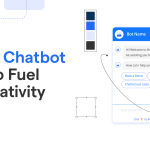
With Gen Z’s fearless personality in mind, some brands are adopting an eye-catching, bright color palette and high-contrast logo design in keeping with its unconventional traits. Natural patterns or scribbles add an uninhibited quality that fits right in with Gen Z.
Bold typography makes an immediate impactful statement and reinforces brand personality while building brand recognition – something travel, snack, and soft drink companies can especially take advantage of with this logo trend.
Color Blocking
Color blocking, or large blocks of contrasting colors, helps your logo stand out in an increasingly competitive marketplace. Popular with soft drink and travel brands that wish to appear youthful and fresh, color blocking is also often utilized when used in product packaging or posters.
Color blocking can be easily accomplished by pairing colors that fall opposite each other on the color wheel, creating natural contrast that’s easy on the eyes. But you could also experiment with analogous hues – those which lie next to one another on the color wheel – which create a subtler but equally effective effect, like this purple and orange combination color block design.
Color blocking can help brands ensure all their SKUs fit nicely in a retail shelf display. It helps customers quickly locate what they’re searching for while simultaneously showing your brand is cohesive and carefully considered.
Industrial Text Logos
Industrial text logos offer brands looking for a rugged, bold and confident visual identity the ideal solution. They typically feature block monograms or glyphs reminiscent of hardware, software or construction-related elements like railyards. Industrial text logos have proven particularly effective among tech and construction companies but can work equally well when conveying innovation or resilience.
This logo trend is founded on the idea that an effective logo must be adaptable enough to adapt to multiple formats, from wide billboard landscapes and smartphones/smartwatches, down to smartphones with smaller real estate or color scaleability needs.
Though this style of logo design might appear outdated, its recent surge in popularity demonstrates a deeper understanding of design trends among modern professionals. This logo trend incorporates minimalist shapes and reserved typography from previous trends with natural patterns and hand drawn sketches for truly memorable logo designs.
Illustrative Typography
With the recent proliferation of brand logos featuring illustrated characters, it may appear that simple word marks are becoming obsolete. But creating an effective typographic logo requires just as much thought and effort – it should work in different situations while reproducing beautifully at smaller sizes; furthermore it may involve using fonts, entirely custom typefaces and embellishments like ligatures and swashes for maximum effectiveness.
An illustrated character or mascot can communicate a brand’s personality and tone in ways words cannot. These strong and eye-catching logos typically incorporate elements that represent core values as part of their design, providing insight into who the business really is.
Geometric images that sum up the brand’s mission or values into simple geometric forms or hand-drawn icons with nostalgia-inducing elements add flair to brand identities.
Interactive Logos
Logos that serve as their main graphic element allow brands to convey the overall tone, style and personality of their company in one iconic image. Logos also serve as ideal branding strategies on digital platforms as users can interact with them to learn more about the product they represent.
As life becomes more demanding, some brands are opting to reduce visual stimuli with minimalist, monochrome logos that avoid bold colors and font distortions. This trend of logo design seeks to reduce clutter while getting to the heart of their brands.
Brands looking to take their interactions a step further should embrace animated and interactive logos as a trend that’s revolutionizing how brand identities are displayed, communicated, and experienced in today’s branding environment. These dynamic symbols adapt and change in response to user engagement – providing viewers with a hands-on experience that creates more intimate bonds with your brand over time.






